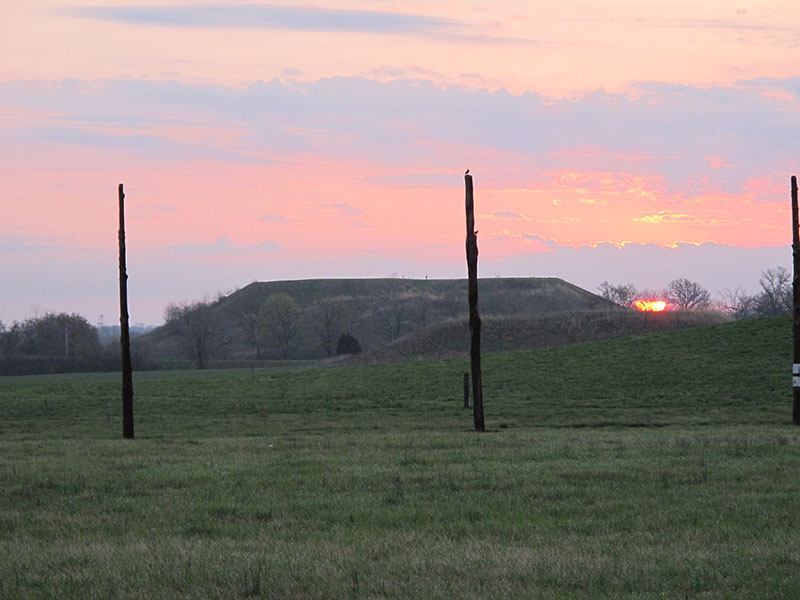- Apply
- Visit
- Request Info
- Give



Published on December 22, 2022

Sunrise at Monk’s Mound at Cahokia. The posts are a reconstruction of a Cahokian solstitial calendar. They are part of a circle of posts, known as Woodhenge, marking the sun’s position at the solstice.
Sarah Baires, associate professor of anthropology at Eastern Connecticut State University, is the principal investigator on a new National Science Foundation (NSF) grant to conduct an archaeological study in Cahokia, an indigenous city in southern Illinois that was the largest in North America in medieval times and now is a UNESCO World Heritage Site and a state historic site.
She will study the early occupation of the city, looking at how neighborhoods on the outskirts of the urban area related culturally and in infrastructure to the core “downtown” area. As many as 20,000 people lived in Cahokia, which is on the Illinois side of the Mississippi River near present-day St. Louis, MO.
Baires has studied Cahokia for more than 10 years and has written several books about it, most recently, “Cahokia and the North American Worlds” (March 2022, Cambridge University Press). Her research has been featured in documentaries on PBS and the Smithsonian Channel.

Her co-principal investigator, Melissa Baltus, associate professor of anthropology at the University of Toledo, will study the late collapse of the city. Cahokia was a metropolis from roughly 1000 AD to 1400 AD, when London and Paris were also developing. The reason for its abandonment is unknown. Large burial mounds remain and have been extensively excavated.
Eastern students will participate in the new study through archaeological field schools, starting in the summer of 2024. The opportunity will be open first to anthropology majors taking Archaeological Field School (ANT 479), a course in how to do archaeological field work, and then to any students who want to pursue archaeology as a career. Funding is also available to hire student workers during the academic year to conduct artifact analysis in Baires’ lab.
The study at Cahokia will be conducted using non-invasive techniques such as magnetometry. Magnetometers can be pulled across the land for high-speed sampling of what lies beneath the ground, so settlements and structures can be identified without disturbing the soil. The research will focus on two locations at the edge of the city.
Baires will look for evidence of how involved people in peripheral neighborhoods were in the ideologies and practices of core Cahokia. “Were they investing their time and energy into building infrastructure like mounds, borrow pits, and causeways in those locations? she asked. “Were they building and maintaining public architecture like shrines and meeting houses in their neighborhoods?”
Learning how connected they were to the practices of people in the inner city may shed light on how long they stayed in Cahokia and whether they left it earlier than those in the central area. “This may help people understand the nuanced relationship between social investment and local participation, diversity of neighborhood identities, and the future of modern cities from a bottom-up, grass-roots perspective,” she said.
“This research will help us further understand the drive behind why human beings began to congregate in cities … what was the motivating factor? What did they gain from being part of a city?” Baires asked. This could be applied to contemporary experience, she said, particularly in the face of human migration and movement beyond cities and into new cities.
The research will also create opportunities for the contemporary community members, many of them immigrants or first-generation residents, to understand similarities and differences between their modern experiences and those of people living in Cahokia in the past, she said.
The NSF award is for five years with a total funding allotment of $128,000.
Written by by Lucinda Weiss